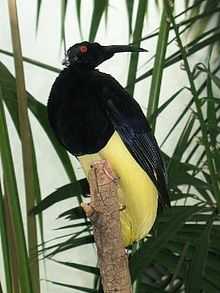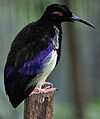Twelve-wired bird-of-paradise
| Twelve-wired bird-of-paradise | |
|---|---|
 | |
| Male | |
| Conservation status | |
| Scientific classification | |
| Kingdom: | Animalia |
| Phylum: | Chordata |
| Class: | Aves |
| Order: | Passeriformes |
| Family: | Paradisaeidae |
| Genus: | Seleucidis Lesson, 1834 |
| Species: | S. melanoleucus |
| Binomial name | |
| Seleucidis melanoleucus (Daudin, 1800) | |
The twelve-wired bird-of-paradise (Seleucidis melanoleucus) is a medium-sized, approximately 33 cm (13 in) long, velvet black and yellow bird-of-paradise. The male has a red iris, long black bill and rich yellow plumes along its flanks. From the rear of these plumes emerge twelve blackish, wire-like filaments, which bend back near their bases to sweep forward over the birds hindquarters. The female is a brown bird with black-barred buffy underparts. Its feet are strong, large-clawed and pink in color.
The sole representative of the monotypic genus Seleucidis, the twelve-wired bird-of-paradise is a bird of lowland forests. The male displays on an exposed vertical perch with its breast-shield flared. Its diet consists mainly of fruits and arthropods in addition to frogs, insects and nectar.[2]
It is found in flat lowlands and swamp forests,[2] particularly throughout New Guinea and Salawati Island, Indonesia. The twelve-wired bird-of-paradise is evaluated as Least Concern on the IUCN Red List of Threatened Species,[1] and is listed on Appendix II of CITES. It has not been easy to breed it in captivity. The first successful captive breeding program was at Singapore's Jurong Bird Park, in 2001.[3]
-

Female
-

A male in Jurong Bird Park
References
- ↑ 1.0 1.1 BirdLife International (2012). "Seleucidis melanoleucus". IUCN Red List of Threatened Species. Version 2013.2. International Union for Conservation of Nature. Retrieved 26 November 2013.
- ↑ 2.0 2.1 Michael, Hugill (24 March 2011). "Twelve-wired Bird of Paradise". australianmuseum.net.au. Retrieved 10 October 2014.
- ↑ "Wildlife Reserves Singapore". www.wrs.com. Retrieved 10 October 2014.
External links
- BirdLife Species Factsheet
- Video showing Bird-of-Paradise courting a female Tim Laman. Jayapura Western New Guinea. June 2010.
| Wikimedia Commons has media related to Seleucidis melanoleucus. |
